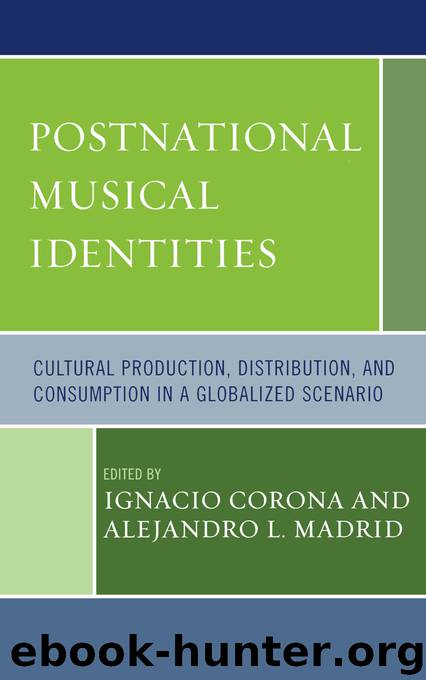Postnational Musical Identities by Ignacio Corona & Alejandro L. Madrid

Author:Ignacio Corona & Alejandro L. Madrid
Language: eng
Format: epub
Publisher: Rowman & Littlefield
Published: 2008-06-14T16:00:00+00:00
Chapter 7
Quest for the Local: Building Musical Ties between Mexico and the United States
Helena Simonett
As globalization unfolds, relationships between place, music, and cultural identity are increasingly more tenuous. But despite the apparent irrelevance of place in today’s globalized world and its cultural products, it is “the local” that gives credibility to music. Moreover, music is commonly linked to place through claims to tradition, authenticity and originality, and as a marketing strategy. This essay will address such issues by focusing on a number of musical styles hugely popular among audiences of Mexican heritage: the acoustic banda [wind band] from Mexico’s northern Pacific coast (in particular the state of Sinaloa), technobanda, banda’s modernized version which was created in Guadalajara and popularized in Los Angeles in the early 1990s, el pasito duranguense [“the little dance step from Durango”], an updated version of a regional music style from the sierra state of Durango that made Chicago’s immigrant communities dance into the new millennium, deejays’ sonido music which reverberates in Mexican youths clubs in New York and other large cities, and the accordion-driven norteña music prevailing throughout northern Mexico and the U.S. Southwest. Banda and norteña music share a common history: they originated in the rural areas of Mexico’s northern provinces, were primarily performed at dances and in cantinas [taverns], and have been popular among the working class. Thus, the more affluent classes have long despised these music styles as “backward” and “disreputable.” Technobanda, designed as a synthesized version of Sinaloan banda with norteño flavor, shares some of these traits, although it was able to transcend the social context in which it originated by appealing to a less prejudicial audience in a different geographic and social setting.1 Similarly, the duranguense “Chicago sound” recreates Mexican brass- band sound with synthesizers and drum to interpret fast-paced rancheras [romantic countryside-style songs]. Moreover, young artists have recently used both banda and norteña in fresh contexts. Digitally recycled by the Tijuana-based Nor-tec bands and rapped over by Akwid and Jae-P from South Central Los Angeles, traditional Mexican music has crossed into the scenes of electronic music and Chicano/Latino hip-hop.
Download
This site does not store any files on its server. We only index and link to content provided by other sites. Please contact the content providers to delete copyright contents if any and email us, we'll remove relevant links or contents immediately.
The Goal (Off-Campus #4) by Elle Kennedy(13602)
Kathy Andrews Collection by Kathy Andrews(11765)
Diary of a Player by Brad Paisley(7520)
What Does This Button Do? by Bruce Dickinson(6168)
Assassin’s Fate by Robin Hobb(6162)
Big Little Lies by Liane Moriarty(5745)
Altered Sensations by David Pantalony(5071)
Pale Blue Dot by Carl Sagan(4953)
Sticky Fingers by Joe Hagan(4143)
The Death of the Heart by Elizabeth Bowen(3578)
The Heroin Diaries by Nikki Sixx(3516)
Beneath These Shadows by Meghan March(3281)
Confessions of a Video Vixen by Karrine Steffans(3273)
How Music Works by David Byrne(3233)
The Help by Kathryn Stockett(3115)
Jam by Jam (epub)(3048)
Harry Potter 4 - Harry Potter and The Goblet of Fire by J.K.Rowling(3031)
Computational Linguistics and Intelligent Text Processing: 20th International Conference, CICLing 2019 La Rochelle, France, April 7â13, 2019 Revised Selected Papers, Part I by Alexander Gelbukh(2965)
Strange Fascination: David Bowie: The Definitive Story by David Buckley(2833)
